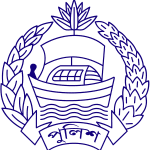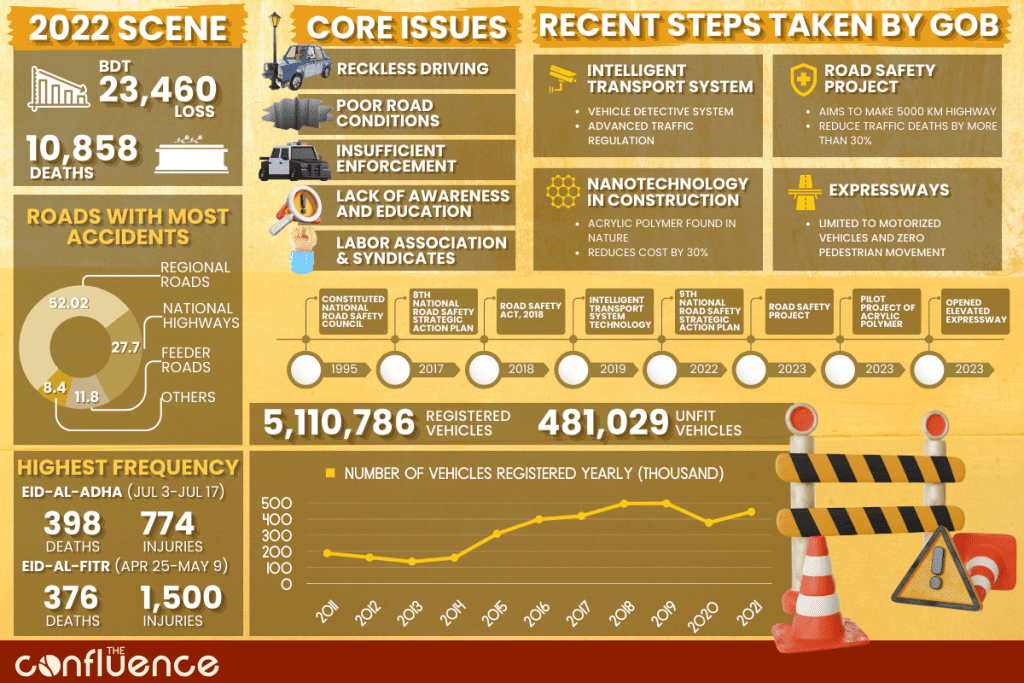One of the major policy issues facing Bangladesh is its road safety. A country with very little implementation of traffic laws and little awareness like Bangladesh has to ensure that there are better policies to tackle the hazard of road accidents. Road safety has not exactly been a success story for Bangladesh.
The bane of road accidents emerges as a malevolent force capable of unleashing havoc upon human existence, casting a pall of terror over every individual. According to the World Health Organisation’s ranking published in 2020, Bangladesh ranked 88th among 183 countries in road accident death rates. The death rate is 16.74 per 100,000, Obaidul Quader, MP and Minister of Road Transport and Bridges, said in an interview.
It is estimated that Bangladesh faces a financial loss of around Tk 25, 000 crore, which is 1.5% of the GDP, due to road accidents every year. The monetary loss from traffic accidents in Bangladesh in 2022 was predicted to be Tk 23,460 crore. Apart from the monetary loss, road accidents can cause loss of lifelong physical ability, damage vehicles, roads, any other infrastructures, materials, resources, etc. It destroys environments, increases pollution, creates social chaos, political unrest, commotion, and accelerates violations of rules as well.
The Current Road Safety Situation in Bangladesh
The current road safety situation in Bangladesh is causing distress to the general public. According to a World Bank report, the mortality rate associated with traffic accidents decreased from 2005 to 2018. In 2019, the trend started to take a leap due to increasing vehicles, a lack of awareness, and syndicates. During 2020, when movements of all road transports remained suspended for two months in a row after the COVID outbreak in Bangladesh, 3,918 people were killed and 3,826 injured in 4,198 road crashes, according to police data.
Moreover, a total of 10,858 people were killed and 12,875 others injured in 7,617 road, railway, and waterway accidents across the country in 2022, according to the Bangladesh Jatri Kalyan Samity. It is the highest figure in the last eight years. Deaths in road crashes saw a rise of 27.43% in 2022 compared to 2021. The report found that 52.02% of accidents last year were on regional highways, 27.70% on national highways, and 11.88% on feeder roads. Moreover, these accidents frequently involve pedestrians, cyclists, and motorcycle riders.
However, data published by the Bangladesh Road Transport Authority (BRTA) is often contradictory with Jatri Kalyan Samity’s report. BRTA data shows a slightly lower number of accidents. A recent letter sent by Jatri Kalyan Samity to BRTA states that BRTA’s estimates do not concur with estimates of Bangladesh Police and other private organizations. Even though the trends of increase or decrease in road accidents provided by BRTA and other organizations are more or less similar, the difference in numbers suggests that there are differences in reporting and methodology of road accidents which needs to be uniform across all organizations.
Number of Accidents & Deaths in Different Vehicles during August 2023
Source: BRTA
No Data Found
BRTA’s Monthly Road Accident Report of August 2023 shows that most accidents happen in vehicles such as motorbikes, buses, trucks and others. At the same time, fatalities in motorbike accidents are more than any other type of vehicle.
Challenges to Ensure Road Safety
Several factors contribute to the alarming rate of road accidents in Bangladesh. Some of the core challenges include:
Reckless Driving
Unsafe driving practices such as speeding, rash overtaking, and operating a vehicle while intoxicated continue to be major contributors to accidents. The Bangladesh Road Safety Foundation predicts that reckless driving will be to blame for 82% of Bangladesh’s traffic accidents in 2022. Bangladesh was identified as one of the world’s worst nations for drivers in 2022. The global average of 18.2 road fatalities per 100,000 people is much lower than the number in Bangladesh.
Poor Road Conditions
Poor road conditions are the second most common reason for accidents on Bangladesh’s roads, according to the Bangladesh Road Safety Foundation. 15% of all traffic accidents in Bangladesh in 2022 involved bad road conditions. In Bangladesh, 960 individuals died as a result of dangerous road conditions in the same year. In economic terms, it resulted in billions of Taka in economic damage.
Insufficient Enforcement
The Road Transport Act 2018 calls for a five-year sentence and/or a fine of BDT 500,000 for a driver convicted of being responsible for a traffic death. The fine is 100 times greater than the maximum fine under the previous law. But drivers do not fear the repercussions of their actions because of lax law enforcement in the majority of cases.
Lack of Awareness and Education
A significant portion of road users lack proper awareness of road safety measures. Reckless driving, risky overtaking, dilapidated roads, unfit vehicles, unskilled drivers, and using mobile phones or headphones while driving can be cited as the main reasons behind road crashes.
Number of Registered Vehicles
Currently, the number of authorized (registered) vehicles in the BRTA is 55,82,310. From the BRTA report, we can see that the number of authorized vehicles up to June 2020 was 4471625. Thus, it reveals that the number of authorized vehicles is increasing.
Number of Registered Motor Vehicles in Bangladesh
Source: BRTA
No Data Found
The BRTA report also shows that among the 58 lakh vehicles plying the roads, 72 percent lack fitness clearance. Moreover, vehicles like easybike, nasimon, karimon, and votvoti plying the roads without permission increase the chance of road accidents. There were around 481,029 unfit vehicles in Bangladesh up to June 2021.
0
Unfit Vehicles
Adverse Role of Transport Owners and Workers’ Associations
The bus owners and transport labor associations create unity within the people involved in the process. They have often resisted government efforts to regulate the roads. For example – when the Road Safety Act, 2018 went into action on November 1, 2019, with stricter measures for violation of traffic law, i.e. increased fine and jail terms, the transport owners and workers called for a country-wide strike on November 20. They claimed that the increased fines were higher than their monthly income in some cases.

The bus owners have also resisted efforts to rationalize Dhaka’s bus routes. The late Mayor Anisul Huq envisioned the route rationalization program for which a committee was set up. The Bus Route Rationalization Committee’s plan was to introduce a single bus service named “Nagar Paribahan” under the supervision of the city corporation and for all buses to be operated through Nagar Paribahan, by leasing them from the current owners. The pilot program started with the capital’s Ghatarchar to Kanchpur route where all buses other than Nagar Paribahan were announced illegal and other buses on that route were asked to lease their buses to Nagar Paribahan. Nagar Paribahan has specific bus stoppages and ticketing systems. However, the other operators on that route didn’t stop their service and resisted Nagar Paribahan’s plan. Dhaka Transport Coordination Authority’s report on the Nagar Paribahan pilot project mentioned that the major obstacle was these unauthorized buses and unhappy drivers, even though the passengers were happy with the service. Despite its limitations, Nagar Paribahan launched on 3 new routes from September 1, 2022. However, the effectiveness of the route rationalization program is still questionable due to the resistance imposed by the transport owners and workers.
Steps Taken by the GoB to Ensure Road Safety
Back in 1995, the government constituted the National Road Safety Council to implement and monitor road safety activities. But that step was not successful in achieving the goal. Failing to achieve the target, the NRSC, in November 2017, approved the 8th National Road Safety Strategic Action Plan with the aim of achieving SDG target 3.6. In June 2017, Bangladesh declared October 22 as National Safe Roads Day as well, to spread awareness among people.
After the 2020 UNGA resolution, the National Road Safety Council in November 2022 approved the Ninth National Road Safety Strategic Action Plan for 2021–2024 with the goal to reduce the number of road accident fatalities and injuries in Bangladesh by 20 to 25 percent by 2024 and by 50 percent by 2030.
Road Safety Project
The Bangladesh government inaugurated the first dedicated Road Safety Project in South Asia on June 14, 2023, which got approval from ECNEC. The project, backed by $358 million in financing from the World Bank, will focus on selected cities, high-risk highways, and district roads and will run from 2023 to 2028. The initiative aims to make 5,000 kilometers of highway safer and reduce road traffic deaths by more than 30%. To enhance safety on highways and urban roads, the project will install road signs, dividers, footpaths, raised zebra crossings, speed breakers, and bus bays in five divisions – Dhaka, Khulna, Rajshahi, Rangpur, and Mymensingh. The Roads and Highways Department, Bangladesh Road Transport Authority, Bangladesh Police, and Directorate General of Health Services of the Government of Bangladesh will work together to implement the project. Currently Dhaka-Aricha Highway and Dhaka-Mawa Expressway have dedicated slow lanes for slower moving vehicles, reducing the likelihood of high speed accidents.

Nanotechnology
The government is going to take on a pilot project for using nanotechnology in the construction of roads to ensure road safety with a view to implementing the Sustainable Development Goals (SDGs) by 2030. Under the project, the government will use “Acrylic Polymer”, to reduce road construction costs by at least 30 percent as well as ensure safer roads than the traditional bitumen roads. Previously, bitumen was used as a binder for road construction. But it is possible to modify bitumen quality with the help of nanomaterials. Nanoclay is found in nature and is not costly either. Thus, using nanoclay bitumen, quality can be improved at a low cost. Using carbon nanotubes helps increase the flexibility and strength of bitumen roads. During the winter, bitumen becomes fragile due to the fluctuation in temperature. Nanotechnology helps to maintain the strength of roads and directly reduces the possibility of accidents.
The National Road Safety Strategic Action Plan (2021-2024) has been prepared to ensure road management, planning, driver training, testing, and vehicle safety. 21 different organizations, including the government, private sector, and NGOs, are involved in this plan.
Introduction of Intelligent Transport System:
The Government of Bangladesh is installing automated ITS technology to regulate traffic on two highways under two separate projects at a combined cost of around Tk 2.75 billion. The ‘Vehicle Detective System’ will enable officials to identify speeding vehicles. The Road Transport and Highways Division has taken the initiative to introduce the system on a 40-km stretch of the Bangabandhu Sheikh Mujib National Highway (N8) leading to the Padma Bridge via the Dhaka-Mawa Expressway on a trial basis. Meanwhile, uninterrupted ITS technology will be on hand along the 260-kilometer highway from Gazipur’s Joydebpur to Rangpur. The technology is based on the South Asia Subregional Economic Cooperation (SASEC) initiative. It is scheduled to be completed in December 2025, with financial assistance worth Tk 830 million and technical support from the Korea International Cooperation Agency (KOICA).
Expressways and the Dhaka Elevated Expressway
The GoB introduced Bangladesh’s first elevated expressway project, the Dhaka Elevated Expressway. It will connect Hazrat Shahjalal International Airport via Kutubkhali and has partially opened on September 2, 2023.
Among the other expressways, the Dhaka-Mawa-Bhanga Expressway is the only complete expressway so far built in Bangladesh. Another expressway to connect the northern and southern regions would be constructed from Sylhet’s Tamabil land port to Cox’s Bazar’s Gundum. It will connect Chattogram and Matarbari seaports as well. The construction of the second Padma Bridge has been proposed at Manikganj-Rajbari point for an expressway from Mymensingh’s Gobrakura land port. Meanwhile, an expressway has been proposed from Benapole land port to Cumilla’s Laksam that will be connected to the Tamabil-Gundum expressway. Another proposed expressway is about to connect the Tamabil-Gundum expressway in Brahmanbaria with Chapainawabganj’s Sona Masjid land port.
Expressways are designed primarily for motorized vehicles, with limited access for pedestrians and cyclists. This separation ensures that vulnerable road users are not exposed to the high speeds and traffic volumes typically found on expressways, reducing the risk of accidents involving ‘Pedestrian Hit’.
Moreover, expressways include overpasses and underpasses, eliminating the need for vehicles to cross traffic at the same level. This reduces the potential for high-speed collisions at intersections. According to the International Journal of Research, elevated expressways can reduce accidents by 23%.
Regulating Motorcycle Movement
A BRTA report released on May 9, 2022, reveals that there are about 36.5 lakh registered motorcycles. But there are only about 23.5 lakh driving licenses for motorcycles, which indicates that about 13 lakh people ride motorcycles without a license. To control motorcycle accidents, the NRSC meeting declared a ban on motorcycles on highways, and no registration was required for vehicles declared abandoned.
0
Lac
Motorcycle Riders without License
In 2022, 3,091 people died in 2,973 motorcycle accidents, which contributed to 40.07 percent of the total deaths. Thus, in the same year, ‘Motorcycle Movement Policy, 2023’ was introduced by a committee led by road transport and highways division joint secretary Md. Anisur Rahman. It aims to reduce motorcycle- related accidents, motivate the use of scooters instead of sports bikes, and raise awareness among motorcycle users. According to the draft, motorcycles inside Dhaka cannot exceed a speed of 30 km/h. Motorcycles with less than 126 cc would be barred from moving on highways, and no one can travel in the passenger seat of a motorcycle on highways.
Implementational Challenges
Even though the increasing trend of road accidents is alarming, the recent steps taken by the government can be fruitful if implemented properly. Registration plates of all motor vehicles have been digitized so that vehicles can be easily identifiable. There is very little implementation of speeding tickets on the highways. Even the traffic systems of major cities are controlled without traffic lights. The implementation of the traffic light based system was challenging because drivers were not willing to follow and such a large number of vehicles could not be penalized by traffic police for violation of traffic signals due to shortage of manpower. However, digitization can enable better traffic maintenance because traffic signal violation is now digitally identifiable. But a completely digitized traffic management system is yet to be adopted.
On the other hand, a large number of vehicles are not motorized, like rickshaws. And rickshaw pullers do not have any licensing and therefore, if they break traffic rules, it is challenging to fine them for violation.
Government Agencies that are Working to Ensure Road Safety

Bangladesh Road Transport Authority (BRTA)

Accident Research Institute (ARI), Bangladesh University of Engineering and Technology (BUET)

Bangladesh Police
These groups include Bangladesh Road Transport Authority (BRTA), Accident Research Institute (BUET), Bangladesh Police, Safe Road and Transport Alliance (SROTA), Bangladesh Sarak Paribahan Malik Samity, Bangladesh Bus-Truck Owners’ Association, Bangladesh Society for Emergency Medicine (BRAC), and many more organizations
Recommendations
Currently, there are 41 BRTA-approved driving schools in Bangladesh. But every year, thousands of fledgling drivers are churned out of more than 80 unauthorized driving schools in Bangladesh. The GoB planned to introduce driving courses in technical schools and colleges under the Vocational Education Board in 2012. That plan has not materialized yet. Thus, the introduction of more driving schools and courses is a dire need.
At present, more than 350 road construction projects, with a cumulative value of $5.1 billion, are ongoing in Bangladesh. By keeping aside just 1 percent of the value of these projects for the Road Safety Fund and to educate drivers, we can reduce road fatalities in Bangladesh.
Lack of public transport and traffic congestion bolster the use of bikes and other two-wheelers. Thus, the GoB can maintain separate service lanes on national highways. It will be helpful in reducing bike accidents.
Driving for long hours at a stretch can reduce concentration and lead to accidents. Thus, service centers and restrooms should be installed for drivers at regular intervals on highways.
More cameras, along with speed guns, should be installed in accident-prone areas to discourage drivers from getting engaged in dangerous driving. Meanwhile, wider roads should be established to prevent accidents.
Public transportation should refrain from taking excess passengers during vacations. Relevant laws and punishments should be implemented to prevent the mad rush on public transportation.
Cover photo taken from The Financial Express.
About the Author

Umme Farzana Rupa, a former debater, currently excelling as a passionate student at Bangladesh University of Professionals. Engaging communicator and dedicated learner, she continues to thrive in academics, leaving her mark on campus with her inquisitive spirit and determination

2 comments
Some attitude problem of drivers and bikers on road are often as never follow the lane,
@slow speed vehicle driver run ( 30/40km/h) his vehicle in fast lane with slow speed (30/40km/h) and never give side as a result the fast speed ( 50/60km/h) vehicle overtake wrongly. Even slow speed driver make quarrel if advice to follow lane. It’s cause of accident.
@ it’s rule to keep vehicle on right track within the respective Lane. So that any emergency passengers can go safe place, the small vehicle like motor bike can move and give space for ambulance. But the intention of our drivers to keep vehicle in so close to another vehicle that driver /passengers can’t come out in dangerous time.
@ right ways vehicle is in left ways i.e. U-turn or right way vehicle take turn from left sided Lane they should keep always most right lane for U-turn and right lane for right turn. Never follow it as a result accident and traffic jam occur.
@ BRTA system ( registration and driving license) must be digitalized and share with enforcement agency’s so that in case of any breach of laws/ rules authority can get vehicle information at once and can punish or send notice to the vehicle owner for further. Because, driver ( paid or appointed) always follows owner more than the rules! If notice send to the owner ( appointing authority) for legal action the owner will keep driver within the rules . Need Owners help for better traffic management.
Nice article.